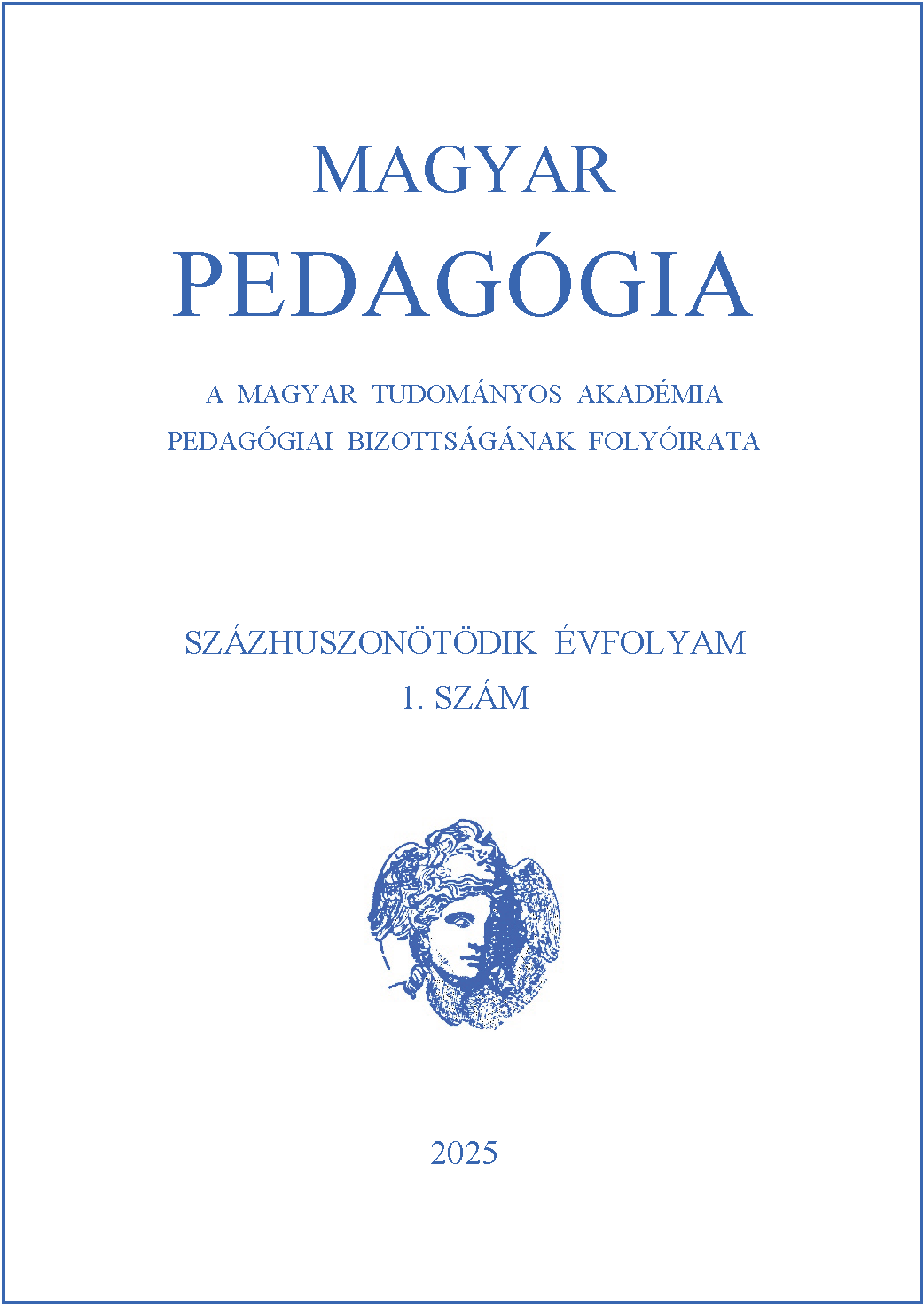magyar
Main Article Content
Abstract
The mathematical thinking and performance of students is crucial for their school success. Although there are numerous standardized tests to measure mathematical performance (which include skills, content knowledge, and strategies), research focused on measuring the use of strategies by students during mathematical problem solving has garnered particular attention in recent decades. Using elementary school mathematical word problems, a wealth of evidence has already been gathered regarding students’ inflexible and ineffective strategy use. Elementary school students tend to adhere strongly to prescribed patterns or algorithms (Csíkos & Szitányi, 2020) when solving word problems. Various solution strategies employed by students can be detected through different methods, including eye tracking (Strohmeier et al., 2020). In our research, we sought to determine how flexible students are in their strategy use when solving mathematical word problems. Our results indicate that students rigidly cling to their previously made decisions, not changing them even when a new possible solution is presented. Based on the results of the eye movement study, we can say that students often do not examine the illustration beside the answer, even though it would aid them in responding. These findings could be important elements in expanding the methodological aspects of mathematics teaching. Educators might place greater emphasis on helping students reconsider their previously made responses, deemed “good”, after learning about alternative, broader interpretations.
Downloads
Article Details
References
Bereczki, I., Biró, F., Turzó-Sovák, N., Szitányi, J., & Csíkos, Cs. (2024). Action research on and for word problem solving: How can Pólya’s problem-solving steps interpreted and enriched in an elementary school? (közlésre benyújtva)
Berends, I. E., & van Lieshout, E. C. (2009). The effect of illustrations in arithmetic problem-solving: Effects of increased cognitive load. Learning and Instruction, 19(4), 345-353. https://doi.org/10.1016/j.learninstruc.2008.06.012
Bóna, J., & Steklács, J. (2020). A hangos olvasás hibajavításának mintázatai szemkamerás és akusztikai, fonetikai vizsgálatok tükrében: Egy 4. osztályosok körében végzett pilotvizsgálat tapasztalatai. Anyanyelv-pedagógia, 13(1), 19-34. https://doi.org/10.21030/anyp.2020.1.2
Boonen, A. J., Reed, H. C., Schoonenboom, J., & Jolles, J. (2016). It's Not a Math Lesson--We're Learning to Draw! Teachers' Use of Visual Representations in Instructing Word Problem Solving in Sixth Grade of Elementary School. Frontline Learning Research, 4(5), 55-82.
Csapó, B., & Molnár, G. (2019). Online diagnostic assessment in support of personalized teaching and learning: The eDia system. Frontiers in Psychology, 10, 1522. https://doi.org/10.3389/fpsyg.2019.01522
Csíkos, C. (2003). Matematikai szöveges feladatok megértésének problémái 10-11 éves tanulók körében. Magyar Pedagógia, 103(1), 35–55.
Csíkos, C. (2022). Metacognitive and non-metacognitive processes in arithmetic performance: Can there be more than one meta-level?. Journal of Intelligence, 10(3), 53. https://doi.org/10.3390/jintelligence10030053
Csíkos, C., & Szitányi, J. (2020). Teachers’ pedagogical content knowledge in teaching word problem solving strategies. ZDM, 52(1), 165-178. https://doi.org/10.1007/s11858-019-01115-y
Csíkos, C., Szitányi, J., & Kelemen, R. (2010). Vizuális reprezentációk szerepe a matematikai problémamegoldásban. Egy 3. osztályos tanulók körében végzett fejlesztő kísérlet eredményei. Magyar Pedagógia, 110(2), 149-166.
De Corte, E., Verschaffel, L., & Op't Eynde, P. (2000). Self-regulation: A characteristic and a goal of mathematics education. In Handbook of self-regulation (pp. 687-726). Academic Press. https://doi.org/10.1016/B978-012109890-2/50050-0
Dewolf, T., van Dooren, W. I. M., & Verschaffel, L. (2015). Mathematics word problems illustrated: An analysis of Flemish mathematics textbooks. Mediterranean Journal of Educational Research, 17, 17-42.
Fonseca, B. A., & Chi, M. T. (2011). Instruction based on self-explanation. In R. E. Mayer & P. A. Alexander (Eds.), Handbook of research on learning and instruction (pp. 296–321). Routledge.
Gonda, Zs. & Steklács, J. (2019). Digitális szövegek olvasási folyamatának vizsgálata szemmozgáskövetéssel. In J. Steklács (Ed.), Szemkamerás vizsgálatok a pedagógiai kutatásban: Tanulmánykötet (pp. 51–68). Kaposvári Egyetem Pedagógiai Kar. Kaposvár.
Hódi, Á., Adamikné Jászó, A., Józsa, K., Ostorics, L., & Sejtes Györgyi, Z. (2015). Az olvasás-szövegértés alkalmazási dimenziójának online diagnosztikus értékelése. In B. Csapó, J. Steklács, & G. Molnár (Eds.), Az olvasás-szövegértés online diagnosztikus értékelésének tartalmi keretei (pp. 105–191). Oktatáskutató és Fejlesztő Intézet.
Johnson, R. B., & Onwuegbuzie, A. J. (2004). Mixed methods research: A research paradigm whose time has come. Educational Researcher, 33(7), 14-26. https://doi.org/10.3102/0013189X033007014
Kelemen, R., Csíkos, C., & Steklács, J. (2005). A matematikai problémamegoldást kísérő metakognitív stratégiák vizsgálata a hangosan gondolkodtatás és a videomegfigyelés eszközeivel. Magyar Pedagógia, 105(4), 343-358.
Kelemen, R. (2010). A matematikai szövegesfeladat-megoldó képesség vizsgálata többségi és tanulásban akadályozott 9-13 éves tanulók körében. Doktori értekezés. SZTE.
Kozhevnikov, M., Hegarty, M. & Mayer, R. E. (2002). Revising the visualizer-verbalizer dimension: Evidence for two types of visualizers. Cognition and Instruction, 20, 47–77. https://doi.org/10.1207/S1532690XCI2001_3
Levie, W. H., & Lentz, R. (1982). Effects of text illustrations: A review of research. Educational Communication and Technology, 30, 195-232. https://doi.org/10.1007/BF02765184
Lewis, A. B., & Mayer, R. E. (1987). Students' miscomprehension of relational statements in arithmetic word problems. Journal of Educational psychology, 79(4), 363-371. https://doi.org/10.1037/0022-0663.79.4.363
Maródi, Á. (2013). A tankönyvi képek és illusztrációk szerepe az oktatásban. Belvedere Meridionale, 25(4), 101-107.
Nagy, J. (1998). A kognitív képességek rendszere és fejlődése. Iskolakultúra, 8(10), 3-21.
OECD (2004). Learning for tomorrow’s world.: First results from PISA 2003. http://www. oecd. org, 4. https://www.oecd.org/content/dam/oecd/en/publications/reports/2004/12/learning-for-tomorrow-s-world_g1gh487c/9789264006416-en.pdf letöltés dátuma: 2025. január 27.
Pintér, K. (2022). Szöveges feladatok tanításának új módszerei. Módszertani Közlemények, 61(3), 95–112.
Pólya György (1957). A gondolkodás iskolája. Bibliotheca.
Pólya, G. (1945). How to solve it—A new aspect of mathematical method. Princeton University Press.
Rayner, K., Chace, K. H., Slattery, T. J., & Ashby, J. (2006). Eye movements as reflections of comprehension processes in reading. Scientific Studies of Reading, 10(3), 241-255. https://doi.org/10.1207/s1532799xssr1003_3
Steklács, J. (2019). A szemkamerás vizsgálati módszer lehetőségei a pedagógiai szempontú kutatásokban. In J. Steklács (Ed.), Szemkamerás vizsgálatok a pedagógiai kutatásban: Tanulmánykötet (pp. oldalszámok). Kaposvári Egyetem Pedagógiai Kar.
Strohmaier, A. R., MacKay, K. J., Obersteiner, A., & Reiss, K. M. (2020). Eye-tracking methodology in mathematics education research: A systematic literature review. Educational Studies in Mathematics, 104(2), 147-200. https://doi.org/10.1007/s10649-020-09948-1
Van Der Schoot, M., Vasbinder, A. L., Horsley, T. M., & Van Lieshout, E. C. (2008). The role of two reading strategies in text comprehension: An eye fixation study in primary school children. Journal of Research in Reading, 31(2), 203-223. https://doi.org/10.1111/j.1467-9817.2007.00354.x
Verschaffel, L., De Corte, E., Lasure, S., Van Vaerenbergh, G., Bogaerts, H., & Ratinckx, E. (1999). Learning to solve mathematical application problems: A design experiment with fifth graders. Mathematical Thinking and Learning, 1(3), 195-229. https://doi.org/10.1207/s15327833mtl0103_2
Verschaffel, L., De Corte, E., & Lasure, S. (1994). Realistic considerations in mathematical modeling of school arithmetic word problems. Learning and Instruction, 4(4), 273-294. https://doi.org/10.1016/0959-4752(94)90002-7
Verschaffel, L., Greer, B., & de Corte, E. (2001). Making Sense of Word Problems. Book Reviews, 33, 1.
Wright, P. (2021). Transforming mathematics classroom practice through participatory action research. Journal of Mathematics Teacher Education, 24(2), 155-177. https://doi.org/10.1007/s10857-019-09452-1

